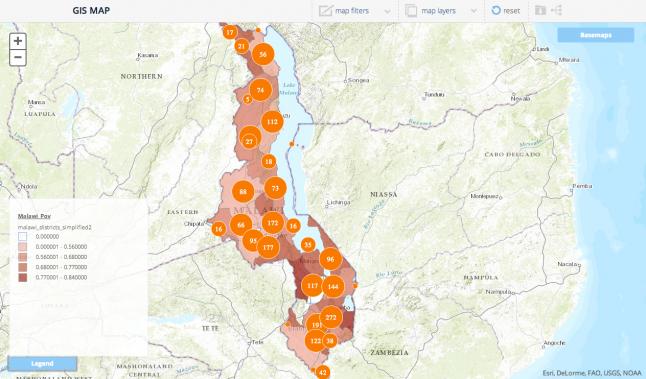Can targeted aid catalyze progress against specific development goals? Analyzing aid allocation and subnational development in Malawi, Rajlakshmi De found evidence that targeted aid can indeed have a significant impact on desired outcomes. In her recent paper, Foreign Aid Allocation and Impact: A Sub-National Analysis of Malawi, De observed a positive relationship between health aid and decreasing disease incidence, water aid and decreasing incidence of diarrhea, and education aid and an increased rate of school attendance. These findings suggest that governments should use information about disease severity, diarrhea incidence, and school enrollment in order to allocate aid more effectively. In addition, De’s research points to the considerable potential of using granular development data to uncover new insights about how aid is actually working in practice.
Traditionally, there has been little information available at a subnational level on the relationship between aid projects by project category and their effectiveness at achieving specific goals. Previous studies have used macroeconomic growth as the dependent variable rather than an increase in living standards. De’s study uses more granular, project-level information to determine the impact of over 5 billion dollars in active aid projects in Malawi. The result is a much clearer picture of whether targeted assistance, in the form of health and water projects, is contributing to tangible improvements for Malawi’s communities.
In measuring the effect of aid on improved living standards, it is difficult to distinguish between impact that can be attributed to development assistance and that which is related to more general economic development. As a result, De chose instead to establish causal linkages by looking at specific aid outcomes that improve soon after the projects are implemented. For example, one would expect a project that purifies water in a localized area to soon lower the incidence of diarrhea, a project that builds and staffs health clinics to reduce the number of days an individual is out of work due to illness, and a project for education to increase school attendance. While cross-country literature is more concerned about aid’s potential to build economic growth, the methodology employed by De’s paper measures factors that can easily be attributed to the specific aid projects.

This map displays the Malawi Aid Management Platform geocoded data with a base layer of poverty rates. Darker shades of red indicate higher rates of poverty per district. Source: aiddata.org
De uses two sources of data in her analysis: project data from aiddata.org and living standards data from the National Statistics Office of Malawi. These data are geographically specific, but some of the AidData information does not include the amount of commitments by geographic location in projects with multiple locations. For this, De assumed that the amount of aid delivered to each district is proportional to the population size. This applies to only a few projects and should not significantly alter findings.
De’s analysis suggests that targeted aid in Malawi is achieving its goals in decreasing illness, decreasing diarrhea, and increasing school attendance. However, the study also highlights the importance of increasing the quantity and quality of subnational development information in order to better measure the benefits to subnational living standards. While the study cannot show that the aid is wholly going to the beneficiaries and is not fueling corruption, it does show the tangible impacts of aid on a micro level. It also reveals that aid may not always go where it is most needed. For example, the incidence rate of diarrhea illness was not a predictor of which locations received the most water supply aid. The results of this study provide a compelling case for how project data and living standards data can be used to more efficiently allocate assistance that yields the type of results needed to address pressing development challenges in a given area.
